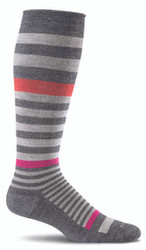How tight are compression socks supposed to be?
11th Feb 2023
Spending a 12 hour shift on your feet can be extremely tough on your feet. Even worse is when you have multiple 12 hour days in a row! A great way to combat the strain put onto your feet and legs is by wearing compression socks. Now for those of us who are not too familiar with wearing compression socks, here is a little run down…
Compression socks, especially now a days, are fashionable socks that provide a tighter fit around your foot, ankle and calves to help with not only great comfort, but also help with blood flow and sweat when either traveling or being on your feet for long periods of time. Some of the fantastic benefits of compression socks: they can help increase circulation leading to fewer varicose veins, help prevent swelling because they prevent blood from pooling below the ankle & the graduated compression also helps reduce fatigue. These amazing benefits are why so many working professionals are starting to trade in their regular socks for compression socks!
A big question we get in our specialty store is how tight should compression socks be or what level of compression do you need? There are multiple grades of compression that you can find, however the most common grade sold for every day wear & to help with circulation & leg fatigue is the moderate compression of 15-20mmHg. This level provides just enough pressure around your lower extremities to where you will still feel comfortable and not notice much of a difference. From here you can go up or down & we have provided a list of options with
8-15 mmHg: This is the lightest form of compression, which is great for energizing your legs. These types of socks provide relief from tired and achy legs. They also help control minor swelling by gently enhancing circulation in the legs.
15-20 mmHg: The mild compression of 15-20 mmHg socks provides relief from minor to moderate swelling, aching, and varicose veins, especially during pregnancy. They are great for preventing deep vein thrombosis (or economy class syndrome) while traveling, but they’re also good for anyone who stands or sits for long periods of time.
20-30 mmHg: The most frequently prescribed level, 20-30 mmHg compression socks offer moderate compression and can be used to treat a variety of mild to moderate conditions. This level can provide relief from varicose veins, edema, deep vein thrombosis, and post-sclerotherapy. This level is also referred to as Class I or firm compression.
30-40 mmHg: Sometimes referred to as Class II compression, 30-40 mmHg socks are often prescribed to provide relief from severe edema, varicose veins, and deep vein thrombosis. They’re also prescribed for post-sclerotherapy and to heal active venous stasis ulcers. This level of compression should only be worn under a doctor’s supervision.
40-50 mmHg: This is the highest level of compression we offer and should only be worn if prescribed by a doctor. This level is typically used to treat chronic venous insufficiency and post-thrombotic syndrome. Your doctor might refer to this level as Class III.
The following chart explains the different levels of compression and what they are typically prescribed to treat. This should just be used to start a dialog with your physician – For anything over 30mmHg always consult a doctor & if you suffer from a vascular disease or blood clots, the best thing is to speak with your doctor on what the best compression grade is for you.
| Condition | Severity | Compression Level |
| Aching Legs | Mild | 8-15 or 15-20 mmHg |
| Diabetes | 8-15 mmHg or No Compression | |
| Deep Vein Thrombosis (DVT) | 20-30 or 30-40 mmHg | |
| Dysautonomia (POTS) | 20-30 or 30-40 mmHg | |
| Economy Class System | 15-20 mmHg | |
| Edema | Mild | 15-20 mmHg |
| Edema | Moderate | 20-30 mmHg |
| Edema | Severe | 30-40 mmHg |
| Ehlers-Danlos Syndrome (EDS) | 15-20 or 20-30 mmHg | |
| Lymphedema | 20-30 mmHg or 30-40 mmHg | |
| May-Thurner Syndrome (MTS) | 20-30 mmHg or 30-40 mmHg | |
| Orthostatic Hypotension | 20-30 mmHg or 30-40 mmHg | |
| Deep Vein Thrombosis | 20-30 mmHg or 30-40 mmHg | |
| Post-Surgical | 20-30 mmHg or 30-40 mmHg | |
| Pregnancy | 15-20 or 20-30 mmHg | |
| Swelling | Mild | 15-20 mmHg |
| Swelling | Moderate | 20-30 mmHg |
| Swelling | Severe | 30-40 mmHg |
| Spider Veins | 15-20 mmHg | |
| Tired Legs | Mild | 15-20 mmHg |
| Varicose Veins | Mild | 15-20 mmHg |
| Varicose Veins | Moderate | 20-30 mmHg |
| Varicose Veins | Severe | 30-40 mmHg |
| Venous Insufficiency | Varies | |
| Venous Stasis Ulcer | 30-40 mmHg |
Please note: The information provided here is for general reference only and is not meant to act as medical advice.
Stop in one of our two convenient locally owned Indianapolis locations today to speak with one of our compression sock experts where you will receive the 5 star service you deserve & find the best selection of compression socks in Indianapolis or shop us on-line at Scrubidentity.com. We look forward to helping you make your perfect purchase!
Scrub Identity North 4655 E 82nd Street Indianapolis 317-863-8681
Scrub Identity South 8219 US 31 Indianapolis 317-893-4431

